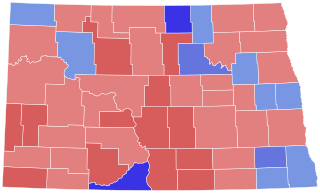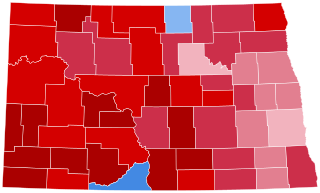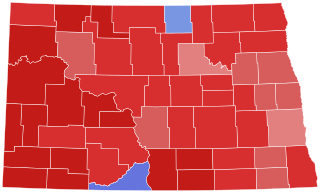
United States gubernatorial elections were held on November 2, 2004, in 11 states and two territories. There was no net gain in seats for either party, as Democrats picked up an open seat in Montana while defeating incumbent Craig Benson in New Hampshire, while Republicans defeated incumbent Joe Kernan in Indiana and won Missouri after Bob Holden lost in the primary. These elections coincided with the presidential election.

United States gubernatorial elections were held on November 7, 2000, in 11 states and two territories. The elections coincided with the presidential election. Democrats gained one seat by defeating an incumbent in West Virginia. As of 2025, this remains the last gubernatorial cycle in which a Democrat won in Indiana.

The 2012 United States Senate election in North Dakota took place on November 6, 2012, concurrently with the 2012 U.S. presidential election, other United States Senate elections, United States House of Representatives elections, and various state and local elections. Incumbent Democratic-NPL Senator Kent Conrad decided to retire instead of running for reelection to a fifth term.

The 2008 North Dakota gubernatorial election took place on 4 November 2008 for the post of Governor of North Dakota. Incumbent Republican governor John Hoeven was easily reelected again, defeating Democratic-NPL challenger Tim Mathern. The primaries took place on June 10, 2008. John Hoeven outperformed John McCain, the Republican presidential nominee, by about 21%. McCain defeated Democratic nominee Barack Obama 53%–45% in the concurrent presidential election.

The 2000 North Dakota gubernatorial election took place on November 7, 2000 for the post of Governor of North Dakota. Incumbent Republican governor Ed Schafer decided not to run for reelection. Republican nominee John Hoeven won the election over Democratic State Attorney General Heidi Heitkamp. Heitkamp had led in the polls until early October, when reports indicated that she had breast cancer, and would undergo surgery. She ran advertisements to assure voters she was still fit to serve; however, by the final month, Hoeven had taken a six-point lead in polling. As of 2021, this is the most recent North Dakota gubernatorial election in which the Democratic nominee received over 40% of the vote. Hoeven and Heitkamp later served alongside each other in the United States Senate from 2013 to 2019.

The 2012 North Dakota gubernatorial election was held on November 6, 2012, to elect a Governor and Lieutenant Governor of North Dakota, concurrently with the 2012 U.S. presidential election, as well as elections to the United States Senate, elections to the United States House of Representatives and various state and local elections. Incumbent Governor Jack Dalrymple succeeded to the office when then-Governor John Hoeven resigned to take a seat in the U.S. Senate in 2010. Dalrymple, a member of the Republican Party, won election to a full term. Ryan Taylor was the Democratic nominee. Dalrymple prevailed with 63% of the vote; he declined to seek re-election in 2016.

The 2016 North Dakota gubernatorial election was held on November 8, 2016, to elect the Governor and Lieutenant Governor of North Dakota, concurrently with the 2016 U.S. presidential election, as well as elections to the United States Senate, elections to the United States House of Representatives and various state and local elections. This would have been the first time North Dakotans selected a governor under new voter ID requirements, in which a student ID was insufficient identification to vote, but a court ruling in August 2016 struck the down the provision; the election was held under the 2013 rules.

The 2016 United States presidential election in North Dakota was held on Tuesday, November 8, 2016, as part of the 2016 United States presidential election in which all 50 states plus the District of Columbia participated. North Dakota voters chose electors to represent them in the Electoral College via a popular vote, pitting the Republican nominee, businessman Donald Trump, and running mate Indiana Governor Mike Pence against Democratic nominee, former Secretary of State Hillary Clinton, and her running mate Virginia Senator Tim Kaine. North Dakota has three electoral votes in the Electoral College.

The 2020 North Dakota gubernatorial election was held on November 3, 2020, to elect the governor and lieutenant governor of North Dakota, concurrently with other federal and statewide elections, including the U.S. presidential election. Incumbent Republican governor Doug Burgum and lieutenant governor Brent Sanford were both re-elected to a second term.

The 1920 United States Senate election in North Dakota took place on November 2, 1920. Incumbent Senator Republican Senator Asle Gronna ran for re-election to a third term. However, he was narrowly defeated in the Republican primary by Edwin F. Ladd, the President of the North Dakota Agricultural College, who had been endorsed by the Nonpartisan League. In the general election, Ladd was opposed by H. H. Perry, the Democratic nominee and a Democratic National Committeeman. As Republican presidential nominee Warren G. Harding overwhelmingly won North Dakota over Democratic nominee James M. Cox, Ladd also staked out a wide victory—though his margin of victory was not as large as Harding's.

The 1968 North Dakota gubernatorial election was held on November 5, 1968. Incumbent Democrat William L. Guy defeated Republican nominee Robert P. McCarney with 54.82% of the vote.

The 1930 North Dakota gubernatorial election was held on November 4, 1930. Incumbent Republican George F. Shafer defeated Democratic nominee Pierce Blewett with 73.62% of the vote.

The 1968 South Dakota gubernatorial election was held on November 5, 1968.

The 1924 North Dakota gubernatorial election was held on November 4, 1924.

The 1912 South Dakota gubernatorial election was held on November 5, 1912. Incumbent Republican Governor Robert S. Vessey declined to run for re-election to a third term. Lieutenant Governor Frank M. Byrne won the Republican primary to succeed Vessey, and then faced State Senator Edwin S. Johnson, the Democratic nominee, in the general election. Byrne only narrowly defeated Johnson, winning just 49% of the vote to Johnson's 46%, the closest gubernatorial election since 1898.

The 1902 North Dakota gubernatorial election was held on November 4, 1902. Incumbent Republican Frank White defeated Democratic nominee J. Cronan with 62.68% of the vote.

The 1889 North Dakota gubernatorial election was held on October 1, 1889. Republican nominee John Miller defeated Democratic nominee William N. Roach with 66.58% of the vote.

The 1914 South Dakota gubernatorial election was held on November 3, 1914. Despite a close election in 1912, incumbent Republican governor Frank M. Byrne defeated Democratic nominee James W. McCarter, an Edmunds County Judge, with 50.07% of the vote. Coincidently, Bryne's Democratic opponent in 1912, Edwin S. Johnson, was elected the same year to represent South Dakota in the United States Senate.

The 2024 North Dakota gubernatorial election was held on November 5, 2024, to elect the governor of North Dakota. Incumbent Republican governor Doug Burgum decided to not seek re-election to a third term; he would ultimately decide to run for president. North Dakota is a Republican stronghold, and the Democratic–Nonpartisan League (NPL) Party has not won a governor's race in the state since 1988.






















